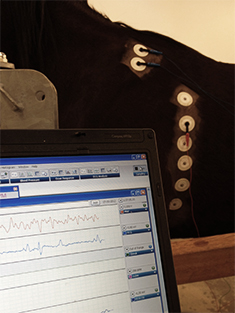Induced short-termed atrial fibrillation (AF) in horses: The pharmacological potential of flecainide and inhibition of small conductance Ca2+ activated K+ channels in the treatment of equine AF
Principal investigators: Rikke Buhl and Thomas Jespersen
Study Director: Maria M. Haugaard
Master students: Eva Z. Hesselkilde
Background:
As humans, horses develop spontaneous atrial fibrillation (AF) in paroxysmal and persistent forms. AF is linked to reduced athletic performance and is the most prevalent pathological arrhythmia in horses. Pharmacological treatment of AF is mainly based on the use of ion channel inhibitors. Current anti- arrhythmic drugs used in the treatment of AF, both in horses and in humans, are limited in their efficacy. Treatment is challenged by the fact that ion channel inhibition introduced by current anti- arrhythmic compounds is non-specific leading to altered ion channel function in all cardiac chambers, not only in the atria as desired. The result of treatment may therefore lead to potential lethal ventricular arrhythmias like Torsades de pointes and ventricular fibrillation. Serious investigations are therefore conducted worldwide to improve already existing treatment protocols, discover new atria selective compounds and new therapeutic targets to advance the pharmacological treatment of AF.
A few studies investigating the potential use of flecainide, a class Ic anti-arrhythmic drug, in equine AF treatment has been conducted, but detailed information concerning the influence of flecainide on equine atrial electrophysiology is lacking.
Small conductance Ca2+ activated K+ (SK) channels have in recent years been linked to atrial repolarization. Promising ex vivo and in vivo reports of the anti-arrhythmic potential of pharmacological inhibition of these channels have been published. However, no data exists on the presence and function of SK channels in horses.
Aim:
The aim of this PhD project is to improve the understanding of the underlying mechanisms of equine atrial fibrillation and the treatment of this disease by:
- Investigating the potential of flecainide to terminate induced AF, protect the heart from AF recurrence in horses and to investigate the effects of flecainide on right atrial refractory period and electrocardiographic parameters (QT and QRS intervals) leading to improve our knowledge about the efficacy and safety of this drug in the treatment of horses with recent onset AF.
- Evaluate the potential of the SK channel inhibitor NS8593 to terminate AF, protect against AF recurrence, and to study the effects of this compound on right atrial effective refractory period (aERP) and electrocardiographic parameters (QT and QRS intervals) in horses.
Methods:
Two in vivo horse models and established (human) programmed stimulation methods is used.
- To address the aim of investigating the potential of flecainide on equine induced short-termed AF I have implemented an in vivo standing horse model using programmed electrical stimulation methods. Horses are non-sedated and function as their own control as atrial refractory period and vulnerability towards induced AF is measured before and after intravenous treatment with flecainde (2 mg/kg).
- To address the aim of evaluating the potential of NS8593 on equine induced short-termed AF I have established an in vivo anesthetized horse model using programmed electrical stimulation methods. Anesthesia is a requirement in this model as NS8593 is a non-approved compound under development. Horses function as their own control as atrial refractory period and vulnerability towards induced AF is measured before and after intravenous treatment with NS8593 (5 mg/kg).
Investigations have been completed, results are published and the PhD-thesis was defended in May 2015.
Picture21

